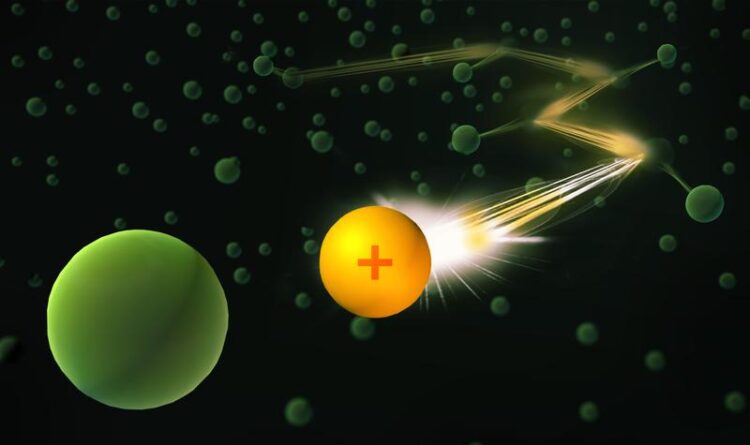Researchers guide a single ion through a Bose Einstein condensate

Artistical visualization of the trajectory of a positively charged ion (yellow) through the BEC (green)
Celina Brandes / University of Stuttgart, Physics 5
Transport processes are ubiquitous in nature but still raise many questions. The research team around Florian Meinert from the 5th Institute of Physics at the University of Stuttgart has now developed a new method that allows them to observe a single charged particle on its path through a dense cloud of ultracold atoms. The results were published in the prestigious journal Physical Review Letters and are subject in a Viewpoint of the accompanying popular science journal Physics.
Meinert‘s team uses a so called Bose Einstein condensate (BEC) for their experiments. This exotic state of matter consists of a dense cloud of ultracold atoms. By means of sophisticated laser excitation, the researchers create a single Rydberg atom within the gas. In this giant atom the electron is a thousand times further away from the nucleus than in the ground state and thus only very weakly bound to the core.
With a specially designed sequence of electric field pulses, the researchers snatch the electron away from the atom. The formerly neutral atom turns into a positively charged ion that remains nearly at rest despite the process of detaching the electron. In a next step, the researchers use precise electric fields to pull the ion in a controlled way through the dense cloud of atoms in the BEC. The ion picks up speed in the electric field, collides on its way with other atoms, slows down and is accelerated again by the electric field. The interplay between acceleration and deceleration by collisions leads to a constant motion of the ion through the BEC.
„This new approach allows us to measure the mobility of a single ion in a Bose Einstein condensate for the very first time“ Thomas Dieterle, PhD student on the experiment, is pleased. The researchers’ next goal is to observe collisions between a single ion and atoms at even lower temperatures, where quantum mechanics instead of classical mechanics dictates the processes. „In future, our newly created model system – the transport of a single ion – will allow for a better understanding of more complex transport processes that are relevant in many-body systems, e.g. in certain solids or in superconductors“ Meinert is sure. These measurements are also an important step on the way to investigate exotic quasi-particles, so-called polarons, which can arise through interaction between atoms and ions.
The neighboring lab at the institute already works on an ion microscope that will allow to directly observe collisions between atoms and ions. While an electron microscope uses negatively charged particles to create an image, this is what happens in an ion microscope with positively charged ions. Electrostatic lenses deflect ions similar to light rays in a classical optical microscope.
The work was created in the Center for Integrated Quantum Science and Technology IQST, a consortium of the universities of Stuttgart and Ulm and the Max Planck Institute for Solid State Research in Stuttgart. The aim of the center is to promote synergies between physics and related natural and engineering sciences and to represent quantum science from the basics to technological applications. Researchers and practitioners from the fields of physics, chemistry, biology, mathematics, and engineering science at IQST investigate the world of quanta in its entirety and in some cases cooperate directly with the industry.
Wissenschaftliche Ansprechpartner:
Contact
Dr. Florian Meinert, University of Stuttgart, Physics 5, f.meinert @ physik.uni-stuttgart.de
Originalpublikation:
T. Dieterle, M. Berngruber, C. Hölzl, R. Löw, K. Jachymski, T. Pfau, and F. Meinert
Transport of a single cold ion immersed in a Bose-Einstein condensate
Physical Review Letters, 2021 https://journals.aps.org/prl/abstract/10.1103/PhysRevLett.126.033401 Article in Physics https://physics.aps.org/articles/v14/8
Media Contact
All latest news from the category: Physics and Astronomy
This area deals with the fundamental laws and building blocks of nature and how they interact, the properties and the behavior of matter, and research into space and time and their structures.
innovations-report provides in-depth reports and articles on subjects such as astrophysics, laser technologies, nuclear, quantum, particle and solid-state physics, nanotechnologies, planetary research and findings (Mars, Venus) and developments related to the Hubble Telescope.
Newest articles

High-energy-density aqueous battery based on halogen multi-electron transfer
Traditional non-aqueous lithium-ion batteries have a high energy density, but their safety is compromised due to the flammable organic electrolytes they utilize. Aqueous batteries use water as the solvent for…

First-ever combined heart pump and pig kidney transplant
…gives new hope to patient with terminal illness. Surgeons at NYU Langone Health performed the first-ever combined mechanical heart pump and gene-edited pig kidney transplant surgery in a 54-year-old woman…

Biophysics: Testing how well biomarkers work
LMU researchers have developed a method to determine how reliably target proteins can be labeled using super-resolution fluorescence microscopy. Modern microscopy techniques make it possible to examine the inner workings…





















